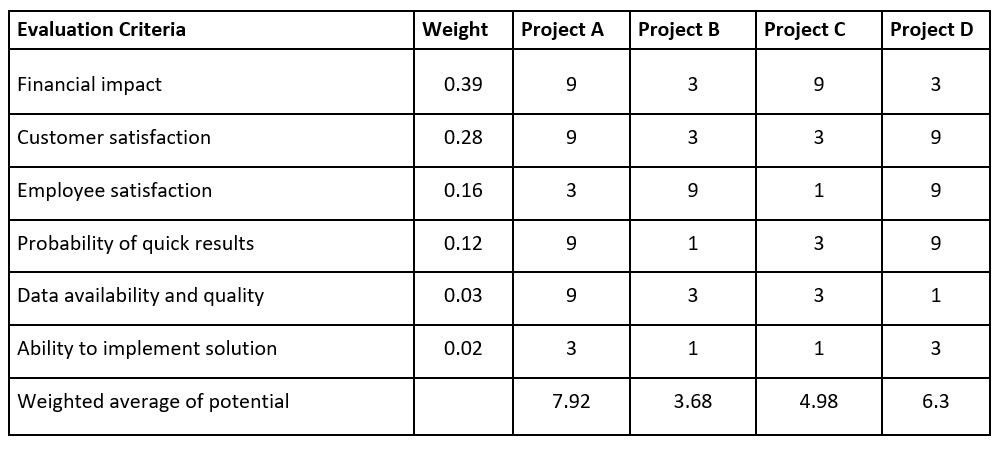How to Use a Decision Matrix to Make the Best Choice!
Decisions, decisions – it seems like every day we are faced with a bunch of them. From major decisions such as which house or car to buy to more minor ones like deciding between bowling or a movie on Friday night. While there are many ways to make these types of decisions including flipping a coin or playing rock, paper, scissors, today we will discuss a more rational technique called a decision matrix.
By the way, speaking of flipping a coin, did you know that there is pseudo-philosophy called flipism? More on that in a bit, but first…
What is a Decision Matrix?
A decision matrix is a relatively simple way to help us choose between different options by comparing them and ranking them against each other based on certain criteria.

The Structure of a Decision Matrix
Before we review an example of a decision matrix, let’s first discuss its structure.
The first column contains a list of the criteria that you will use to make your decision.
The second column contains the weights of the relative importance of each of the criteria.
The third through sixth columns are reserved for the various options you will be considering (options A, B, C, and D. Obviously, this will vary with the number of options that you have.
The cells will hold numbers that denote the relative strength for which each option satisfies each of the criteria.

An Example to Demonstrate How a Decision Matrix Works
Let’s now look at an example of how we would use it to prioritize projects at work. In our hypothetical scenario, we have 4 projects that we could work on, Projects A, B, C, and D.
In order to select the most appropriate project, we have chosen 6 criteria to compare the project options against each other and we have given each of the criteria a weight with respect to how important it is:
 Financial impact 39%
Financial impact 39%
 Customer satisfaction 28%
Customer satisfaction 28%
 Employee satisfaction 16%
Employee satisfaction 16%
 Probability of quick results 12%
Probability of quick results 12%
 Data availability and quality 3%
Data availability and quality 3%
 Ability to implement solution 2%
Ability to implement solution 2%
Each of the criteria and its associated weight is then entered into the table below.
Next, the cell values are assigned, and they evaluate the strength of the relationship between each of the criteria and each potential option (or project in this case).
They are defined as follows:
0 = no relationship between criteria and option (project)
1 = weak relationship between criteria and option (project)
3 = moderate relationship between criteria and option (project)
9 = strong relationship between criteria and option (project)
Each cell value is then multiplied by its respective weight and summed so that each option (project) has a weighted average. The options (projects) are then prioritized by weight, which ranks them in terms of importance based on the evaluation criteria. Obviously, this is not an exact science and is subjective in nature, so it is still possible to make an executive decision to go with a project that is lower on the list due to reasons they deem important.
In our example, we compare the four potential projects based on the criteria that we selected and on the weights that we assigned.

According to our project prioritization matrix, the projects are prioritized as follows:
(1) Project A (7.92)
(2) Project B (6.3)
(3) Project C (4.98)
(4) Project D (3.6)
So, in this example, Project A (7.92) was selected as the highest priority project.
When Should You Use a Decision Matrix?
Some examples of how you can use a decision matrix both in your work and personal lives.
At Work
You can use a decision matrix to choose between:
 Projects you need to complete.
Projects you need to complete.
 Items on your to-do list.
Items on your to-do list.
 Things you need to purchase or vendors who sell them.
Things you need to purchase or vendors who sell them.
…and so on, and so on
In Your Personal Life
You can use a decision matrix to choose between:
 Houses you are looking at purchasing.
Houses you are looking at purchasing.
 Destinations for your next vacation.
Destinations for your next vacation.
 Cars you are looking to purchase.
Cars you are looking to purchase.
 Entertainment options (movies for example).
Entertainment options (movies for example).
…and so on, and so on
Creating a Decision Matrix – The Steps
Let’s quickly go through the various steps you need to take to create your decision matrix.
(1) Select the options you wish to compare and choose between.
(2) Select the criteria you want to use to compare the options.
(3) Assign weights to each of the criteria (note that the weights must add up to 1).
(4) Enter values into the cells to evaluate the strength of the relationship between each of the criteria and each potential project as follows:
0 = no relationship between criteria and project
1 = weak relationship between criteria and project
3 = moderate relationship between criteria and project
9 = strong relationship between criteria and project
(5) Multiply each cell value by its respective weight and summed so that each potential project has a weighted average.
(6) The projects are then prioritized by weight, which ranks them in terms of importance based on the evaluation criteria.
Obviously, this is not an exact science!
And while it is more objective than many other methods, it is still a little subjective in nature.
So, it is still possible that you may want to make an executive decision to go with an option that is lower on the list due to the reasons you deem important.
“Flipism”
Believe it or not, there is an actual pseudophilosophy called flipism where all decisions are made by the flip of a coin. It originated in 1953 in a Disney Donald Duck movie called “Flip Decision” by Carl Banks.
Some famous coins flips in history:
 The city of Portland, Oregon was named after co-founder Francis Pettygrove’s hometown of Portland, Maine by a best two out of three coin flip.
The city of Portland, Oregon was named after co-founder Francis Pettygrove’s hometown of Portland, Maine by a best two out of three coin flip.
 Ritchie Valens won a coin flip with Tommy Allsup for the last seat on Buddy Holly’s plane in 1959. Sadly, the plane crashed and everyone on board perished.
Ritchie Valens won a coin flip with Tommy Allsup for the last seat on Buddy Holly’s plane in 1959. Sadly, the plane crashed and everyone on board perished.
 The Wright brothers flipped a coin to see who would pilot the plane during their first heavier than air flight near Kitty Hawk, NC in 1903. In case you are interested, Wilbur won but he couldn’t keep the plane airborne. A few days later with the plane fixed, it was Orville’s turn and he nailed it!
The Wright brothers flipped a coin to see who would pilot the plane during their first heavier than air flight near Kitty Hawk, NC in 1903. In case you are interested, Wilbur won but he couldn’t keep the plane airborne. A few days later with the plane fixed, it was Orville’s turn and he nailed it!
Personally, I would rather use less random methods such as a decision matrix to make major decisions in my life.
But, if you are ok with using flipism, more power to you – just don’t “flip” me off if things don’t turn out the way you want!
Until next time, use the decision matrix and as always…PYMFP!
–Rick

Use it Or Lose It
The steps for creating a decision matrix that we discussed above are:
(1) Select the options you wish to compare and choose between.
(2) Select the criteria you want to use to compare the options.
(3) Assign weights to each of the criteria (note that the weights must add up to 1).
(4) Enter values into the cells to evaluate the strength of the relationship between each of the criteria and each potential project as follows:
0 = no relationship between criteria and project
1 = weak relationship between criteria and project
3 = moderate relationship between criteria and project
9 = strong relationship between criteria and project
(5) Multiply each cell value by its respective weight and summed so that each potential project has a weighted average.
(6) The projects are then prioritized by weight, which ranks them in terms of importance based on the evaluation criteria.
When to Use It
You can use the decision matrix when making decisions that have multiple options and criteria.
What Do You Think?
Have you ever used a decision matrix or something similar? Could you see yourself using it for certain decisions in your work life or personal life? Please share your thoughts in the comments below!
If you enjoyed this post, it would mean the world to us if you shared it with people you care about via any of the social media platforms below!
Popular Previous Posts:
Being Obsessed with Success: 4 Mantras to Keep in Mind
18 Life Reminders We All Need to Be Reminded Of!
This is the Impact of Asking “And what else?”
How to Rest Your Brain: Why Downtime Boosts Your Uptime!
References
https://wikivisually.com/wiki/Flipism
https://www.theringer.com/2017/2/10/16039966/bill-simmons-five-time-super-bowl-winning-mailbag-288bc8928c09

I think big decisions take a lot more preinvestigative work before making a final decision. The final choice can have a big impact on our life. Consequently, we have to be very cautious. The matrix can be a useful tool ( i.e; house, location, career choice etc. ) Small decisions , I.e; which movie, what to eat are not that big a deal to me. However, I guess if we ate French fries 3x a day , it could have a huge negative impact on our lives. Lol
Hi Eileen, There is no doubt that due diligence is important for big decisions and the matrix can be a helpful tool to do it. Thanks and take care, Rick
People use decision matrices all the time, they just do not realize it. Examples – –
– buying a car or truck: new/used, engine size, cost, seating comfort, towing capability.
– going out to eat: how far to drive, menu selection, pricing.
– going to the movies: action/comedy/mystery, start time, which theater, ticket discounts.
– buying a house: number of rooms, 1 or 2 floors, garage size, location, location, location.
– changing jobs: commute time, salary, benefits, working hours/overtime.
So this really is not a new concept. You have nicely described the process. I think that most people tend to skip the math portion (part 4).
Winds have died down today, so the fire crews and aerial drops should be quite productive, and increase the containment percentage,
Hi Dave, glad to hear the winds have died down so the crews can do their job. Decision matrices are definitely not a new concept but definitely one that more people should use when they are making important decisions. Thanks for the great comment and thoughts and stay safe out there! Best, Rick